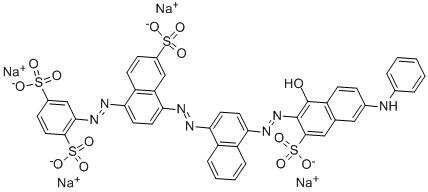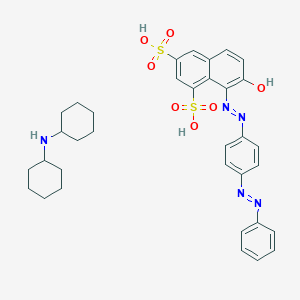Related News
-
Huntsman to Sell Textile Dyeing Unit for $718 Million
2022-08-12 -
Prices of dyes and chemicals are soaring. Industry can't stand idly by.
2019-05-06 -
Brief Analysis of Reactive Dyes Market
2017-09-27 -
50 Printing and Dyeing Mills to Halt Production for Two Days in Xintang
2017-09-21 -
Regulation on Printing and Dyeing Industry Released
2017-09-18 -
Some Dyeing Mills Restarted After the Inspection
2017-09-18
Dye
C.I. Disperse Blue 54
(12217-77-5)-
![Disperse Blue 54 buy Disperse Blue 54]()
Industrial Grade / 99.0%
-
![Disperse Blue 54 buy Disperse Blue 54]()
-
![Disperse Blue 54 buy Disperse Blue 54]()
Industrial Grade / 99%
-
![C.I. Disperse blue 54 buy C.I. Disperse blue 54]()
Industrial Grade or Medical grade / 99%
Request for quotation , get quotes from more suppliers.
-
Industrial Grade / 99%
-
![di-n-butyltin monobutyl maleate buy di-n-butyltin monobutyl maleate]()
Industrial Grade / 99%
-
![di-n-butyltin monobutyl maleate buy di-n-butyltin monobutyl maleate]()
-
![di-n-butyltin monobutyl maleate buy di-n-butyltin monobutyl maleate]()
25kg/Cardboard Drum / 99%
Request for quotation , get quotes from more suppliers.
Disperse Yellow 235
(177570-98-8)-
![Disperse Yellow 235 buy Disperse Yellow 235]()
Industrial Grade / 99%
-
![Disperse Yellow 235 buy Disperse Yellow 235]()
-
![Disperse Yellow 235 buy Disperse Yellow 235]()
-
![Disperse Yellow 235 buy Disperse Yellow 235]()
Industrial Grade / 99%
Request for quotation , get quotes from more suppliers.
C.I. Disperse Orange 47
(12236-03-2)-
![Disperse Orange 47 buy Disperse Orange 47]()
Industrial Grade / 99.0%
-
![C.I. Disperse orange 47 buy C.I. Disperse orange 47]()
Industrial Grade or Medical grade / 99%
-
-
Request for quotation , get quotes from more suppliers.
4-[2-(4-Aminophenyl)diazenyl]-1-naphthalenamine
(6054-48-4)-
![DISPERSE BLACK 1 buy DISPERSE BLACK 1]()
Industrial Grade / 99%
-
![4-[(4-aminophenyl)azo]naphthalen-1-amine buy 4-[(4-aminophenyl)azo]naphthalen-1-amine]()
-
![4-[(4-aminophenyl)azo]naphthalen-1-amine buy 4-[(4-aminophenyl)azo]naphthalen-1-amine]()
Industrial Grade / 99%
-
![4-[(4-aminophenyl)diazenyl]naphthalen-1-amine buy 4-[(4-aminophenyl)diazenyl]naphthalen-1-amine]()
Request for quotation , get quotes from more suppliers.
Direct Blue 78
(2503-73-3)-
![Direct Blue 78 CAS NO 2503-73-3 buy Direct Blue 78 CAS NO 2503-73-3]()
Industrial Grade, Feed Grade, Food Grade, Pharma Grade / 99%
$11.11/KG EXW
-
![Tetrasodium 2-[[4-[[4-[[1-hydroxy-6-(phenylamino)-3-sulphonato-2-naphthyl]azo]-1-naphthyl]azo]-6-sulphonato-1-naphthyl]azo]benzene-1,4-disulphonate buy Tetrasodium 2-[[4-[[4-[[1-hydroxy-6-(phenylamino)-3-sulphonato-2-naphthyl]azo]-1-naphthyl]azo]-6-sulphonato-1-naphthyl]azo]benzene-1,4-disulphonate]()
Different Grade / 99.9%
$0.1/KG EXW
-
![tetrasodium,2-[[4-[[4-[(2Z)-2-(6-anilino-2-oxo-3-sulfonatonaphthalen-1-ylidene)hydrazinyl]naphthalen-1-yl]diazenyl]-6-sulfonatonaphthalen-1-yl]diazenyl]benzene-1,4-disulfonate buy tetrasodium,2-[[4-[[4-[(2Z)-2-(6-anilino-2-oxo-3-sulfonatonaphthalen-1-ylidene)hydrazinyl]naphthalen-1-yl]diazenyl]-6-sulfonatonaphthalen-1-yl]diazenyl]benzene-1,4-disulfonate]()
-
![Direct Blue 78 buy Direct Blue 78]()
Request for quotation , get quotes from more suppliers.
Benzenesulfonic acid, 2,5-dichloro-4-[4-[2-[5-[(4,6-dichloro-1,3,5-triazin-2-yl)amino]-2-sulfophenyl]diazenyl]-4,5-dihydro-3-methyl-5-oxo-1H-pyrazol-1-yl]-, sodium salt (1:2)
(5089-16-7)-
![disodium 2,5-dichloro-4-[4-[[5-[(4,6-dichloro-1,3,5-triazin-2-yl)amino]-2-sulphonatophenyl]azo]-4,5-dihydro-3-methyl-5-oxo-1H-pyrazol-1-yl]benzenesulphonate buy disodium 2,5-dichloro-4-[4-[[5-[(4,6-dichloro-1,3,5-triazin-2-yl)amino]-2-sulphonatophenyl]azo]-4,5-dihydro-3-methyl-5-oxo-1H-pyrazol-1-yl]benzenesulphonate]()
Industrial Grade / 99%
-
![disodium 2,5-dichloro-4-[4-[[5-[(4,6-dichloro-1,3,5-triazin-2-yl)amino]-2-sulphonatophenyl]azo]-4,5-dihydro-3-methyl-5-oxo-1H-pyrazol-1-yl]benzenesulphonate buy disodium 2,5-dichloro-4-[4-[[5-[(4,6-dichloro-1,3,5-triazin-2-yl)amino]-2-sulphonatophenyl]azo]-4,5-dihydro-3-methyl-5-oxo-1H-pyrazol-1-yl]benzenesulphonate]()
-
![disodium 2,5-dichloro-4-[4-[[5-[(4,6-dichloro-1,3,5-triazin-2-yl)amino]-2-sulphonatophenyl]azo]-4,5-dihydro-3-methyl-5-oxo-1H-pyrazol-1-yl]benzenesulphonate buy disodium 2,5-dichloro-4-[4-[[5-[(4,6-dichloro-1,3,5-triazin-2-yl)amino]-2-sulphonatophenyl]azo]-4,5-dihydro-3-methyl-5-oxo-1H-pyrazol-1-yl]benzenesulphonate]()
Industrial Grade / 99%
-
![Reactive Yellow 1 buy Reactive Yellow 1]()
Different Grade / 99.9%
$0.1/KG EXW
Request for quotation , get quotes from more suppliers.
2-Naphthalenesulfonic acid, 3-[2-[4-[2-[4-amino-6(or 7)-sulfo-1-naphthalenyl]diazenyl]phenyl]diazenyl]-6-[2-(2,4-diaminophenyl)diazenyl]-4-hydroxy-, sodium salt (1:2)
(8003-62-1)-
![disodium 3-[[4-[[4-amino-6(or 7)-sulphonatonaphthyl]azo]phenyl]azo]-6-[(2,4-diaminophenyl)azo]-4-hydroxynaphthalene-2-sulphonate buy disodium 3-[[4-[[4-amino-6(or 7)-sulphonatonaphthyl]azo]phenyl]azo]-6-[(2,4-diaminophenyl)azo]-4-hydroxynaphthalene-2-sulphonate]()
Industrial Grade / 98%
-
![disodium 3-[[4-[[4-amino-6(or 7)-sulphonatonaphthyl]azo]phenyl]azo]-6-[(2,4-diaminophenyl)azo]-4-hydroxynaphthalene-2-sulphonate buy disodium 3-[[4-[[4-amino-6(or 7)-sulphonatonaphthyl]azo]phenyl]azo]-6-[(2,4-diaminophenyl)azo]-4-hydroxynaphthalene-2-sulphonate]()
-
![disodium 3-[[4-[[4-amino-6(or 7)-sulphonatonaphthyl]azo]phenyl]azo]-6-[(2,4-diaminophenyl)azo]-4-hydroxynaphthalene-2-sulphonate buy disodium 3-[[4-[[4-amino-6(or 7)-sulphonatonaphthyl]azo]phenyl]azo]-6-[(2,4-diaminophenyl)azo]-4-hydroxynaphthalene-2-sulphonate]()
Industrial Grade / 99%
-
![Direct Black 9 buy Direct Black 9]()
Different Grade / 99.9%
$0.1/KG EXW
Request for quotation , get quotes from more suppliers.
1,3-Naphthalenedisulfonic acid, 7-hydroxy-8-[2-[4-(2-phenyldiazenyl)phenyl]diazenyl]-, compd. with N-cyclohexylcyclohexanamine (1:?)
(6226-87-5)-
![Solvent Red 30 buy Solvent Red 30]()
Industrial Grade / 99%
-
![Solvent Red 30 buy Solvent Red 30]()
Industrial Grade / 99%
-
![Solvent Red 30 buy Solvent Red 30]()
-
Request for quotation , get quotes from more suppliers.
-
![disodium 5-((4-acetylamino-2-sulphophenyl)azo)-6-amino-4-hydroxynaphthalene-2-disulphonate buy disodium 5-((4-acetylamino-2-sulphophenyl)azo)-6-amino-4-hydroxynaphthalene-2-disulphonate]()
Industrial Grade / 99%
-
![disodium 5-((4-acetylamino-2-sulphophenyl)azo)-6-amino-4-hydroxynaphthalene-2-disulphonate buy disodium 5-((4-acetylamino-2-sulphophenyl)azo)-6-amino-4-hydroxynaphthalene-2-disulphonate]()
-
![disodium 5-((4-acetylamino-2-sulphophenyl)azo)-6-amino-4-hydroxynaphthalene-2-disulphonate buy disodium 5-((4-acetylamino-2-sulphophenyl)azo)-6-amino-4-hydroxynaphthalene-2-disulphonate]()
Industrial Grade / 99%
-
![C.I. Acid Red 37 buy C.I. Acid Red 37]()
Different Grade / 99.9%
$0.1/KG EXW
Request for quotation , get quotes from more suppliers.













![4-[(4-aminophenyl)azo]naphthalen-1-amine buy 4-[(4-aminophenyl)azo]naphthalen-1-amine](https://file.echemi.com/fileManage/upload/canonicalSmiles/20220812/c78efe0996cc4dab9bb0174c9ff99979.png)


![disodium 2,5-dichloro-4-[4-[[5-[(4,6-dichloro-1,3,5-triazin-2-yl)amino]-2-sulphonatophenyl]azo]-4,5-dihydro-3-methyl-5-oxo-1H-pyrazol-1-yl]benzenesulphonate buy disodium 2,5-dichloro-4-[4-[[5-[(4,6-dichloro-1,3,5-triazin-2-yl)amino]-2-sulphonatophenyl]azo]-4,5-dihydro-3-methyl-5-oxo-1H-pyrazol-1-yl]benzenesulphonate](https://file.echemi.com/fileManage/upload/cas/24/21f02690-7707-48d9-a230-dfd1cc74137b.gif)
![disodium 2,5-dichloro-4-[4-[[5-[(4,6-dichloro-1,3,5-triazin-2-yl)amino]-2-sulphonatophenyl]azo]-4,5-dihydro-3-methyl-5-oxo-1H-pyrazol-1-yl]benzenesulphonate buy disodium 2,5-dichloro-4-[4-[[5-[(4,6-dichloro-1,3,5-triazin-2-yl)amino]-2-sulphonatophenyl]azo]-4,5-dihydro-3-methyl-5-oxo-1H-pyrazol-1-yl]benzenesulphonate](https://file.echemi.com/fileManage/upload/canonicalSmiles/20220811/bdab72b538a04d2ca3650922a15ae7cc.png)
![disodium 3-[[4-[[4-amino-6(or 7)-sulphonatonaphthyl]azo]phenyl]azo]-6-[(2,4-diaminophenyl)azo]-4-hydroxynaphthalene-2-sulphonate buy disodium 3-[[4-[[4-amino-6(or 7)-sulphonatonaphthyl]azo]phenyl]azo]-6-[(2,4-diaminophenyl)azo]-4-hydroxynaphthalene-2-sulphonate](https://file.echemi.com/fileManage/upload/cas/821/51871b09-dd49-11eb-89d6-0255ac100033.png)
![disodium 3-[[4-[[4-amino-6(or 7)-sulphonatonaphthyl]azo]phenyl]azo]-6-[(2,4-diaminophenyl)azo]-4-hydroxynaphthalene-2-sulphonate buy disodium 3-[[4-[[4-amino-6(or 7)-sulphonatonaphthyl]azo]phenyl]azo]-6-[(2,4-diaminophenyl)azo]-4-hydroxynaphthalene-2-sulphonate](https://file.echemi.com/fileManage/upload/canonicalSmiles/20220812/975ed11a324d432390423bbd996d25ae.png)





